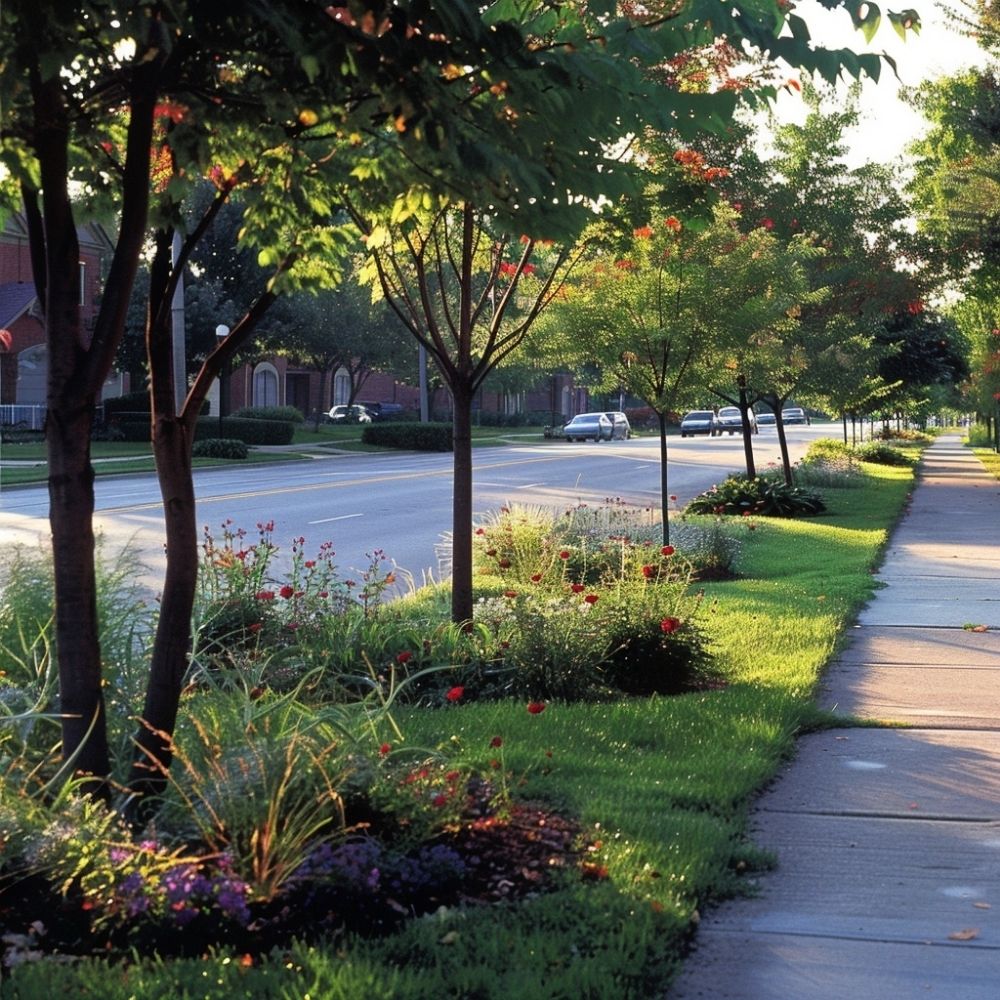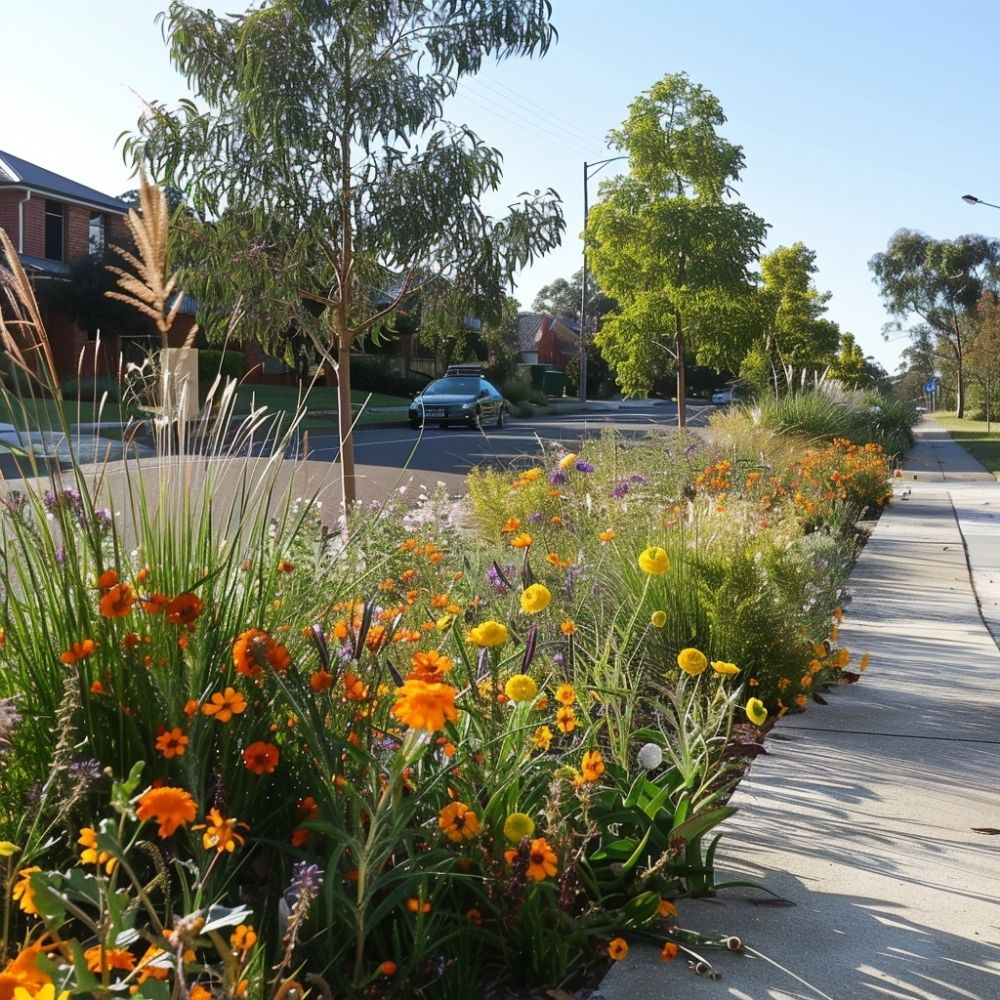Transforming your nature strip can significantly enhance the curb appeal of your property while contributing to the overall aesthetics of your street. In Australia, where outdoor spaces are highly valued, a well-landscaped nature strip not only adds beauty but also serves practical purposes like ensuring pedestrian safety and accommodating essential services. However, navigating the guidelines and balancing functionality with creativity can be challenging.
This article will guide you through innovative and compliant landscaping ideas that respect local regulations and meet community standards. Whether you’re looking to incorporate gravel, mulch, or approved plants, we’ve got you covered with tips and insights to make your nature strip both attractive and functional.
Understanding Nature Strip Landscaping in Australia
The Concept of Nature Strips

Nature strips, or street verges, are public spaces usually found between the road and private property boundaries. They’re often characterised by grass or a simple street tree but can be transformed using various landscaping options. These strips enhance the street’s aesthetic appeal and provide practical functions. Ground cover, mulch, and approved low-height plants are some valid alternatives to traditional grass.
Importance of Nature Strips in Urban Layouts
Well-maintained nature strips contribute significantly to urban environments. They provide clear pathways for pedestrians, space for essential services like postal delivery, and areas for waste collection. In areas lacking formal footpaths, maintaining a 1800 mm grass strip between your property and the planted area is crucial for pedestrian safety and possible future footpath construction. Fire hydrants, often located underground, must remain accessible, identifiable by their blue reflectors.
Additionally, street trees, protected by council regulations, play a vital role in environmental sustainability. As these trees need care, you are responsible for any within your boundary, and any modification requires prior approval.
Keeping Regulations in Mind
Landscaping alterations on nature strips must follow local guidelines, such as those set by your city council and others. Most councils accept synthetic turf and certain types of gravel. However, some items are generally unacceptable, including ponds, water fountains, permanent fencing, and play equipment.
For example, here are the guidelines provided by Monash Council property owners with planting information and advice.
Before starting any changes, reviewing the specific nature strip policy for your locality is essential, especially if you live in new subdivisions with potentially restrictive covenants. Planting on nature strips need to follow strict guidelines and you might need permit.
This structured approach ensures that your efforts align with community standards and contribute to the overall functionality and beauty of your street.
Legal Framework and Guidelines
National Regulations Overview
Australian nature strips are governed by various national regulations. These guidelines help maintain public safety and aesthetics. They provide a framework for homeowners on permissible landscaping activities.
The standards ensure that essential services and utilities are accessible. Compliance with these regulations is necessary to avoid penalties. Clearances must be maintained for fire hydrants and pedestrian pathways.
Local Council Variations
Local councils may have specific rules for nature strips. Differences can include permissible plants, materials, and structures. Always check with your council before starting any project.
Certain items are generally disallowed, such as ponds, water fountains, and permanent fencing. Local guidelines will detail the exact do’s and don’ts for your area.
Each council provides detailed policy documents. Adherence to these ensures that your landscaping efforts meet community standards. Always consult these resources for accurate, up-to-date instructions.
Planning Your Nature Strip Garden
Evaluating the Space

Understand the boundaries of your nature strip. Check local council regulations regarding plant types, height structures, and clearance requirements. These rules ensure pedestrian and traffic safety. Identify any underground utilities by contacting Before You Dig; this avoids damaging infrastructure or exposing hazards. Consider the proximity to hard surfaces, as these can heat up significantly during summer. Choose hardy plants that withstand these conditions.
Choosing the Right Plants

Select landscaping plants based on sunlight and shade availability. Most vegetables require at least six hours of sunlight daily. If your space is shaded, opt for shade-tolerant herbs and plants. Avoid plants needing staking for safety reasons. Check what’s in season at your local stores and prefer native or drought-tolerant species. Plants such as rosemary, thyme, and lavender thrive in these conditions and enhance the aesthetic appeal of your strip.
Recommended Plants for Nature Strips
Ground Cover Plants

Opt for ground covers to add visual appeal and prevent weeds. Consider hardy varieties that thrive in Australian conditions. Atriplex semibaccata, known for its resilient nature, spreads well and retains moisture. Brachyscome multifida, with its bright purple flowers, provides year-round colour.
Carpobrotus species, or pigface, are succulent and require minimal water. Chrysocephalum apiculatum, often called yellow buttons, adds a splash of yellow and attracts beneficial insects. Grevillea species offer diverse foliage patterns and are insect-friendly.
Enchylaena tomentose, a saltbush variant, is especially resilient in coastal areas. Hardenbergia violacea, or native sarsaparilla, with its regal purple flowers, enhances aesthetic appeal. Kennedia prostrata, also known as running postman, flourishes with vibrant red blooms. Lastly, Xerochrysum bracteatum, or everlasting daisy, maintains colour throughout the year.
Native Australian Plants

Choosing native plants ensures sustainability and beauty. Correa species are excellent with their bell-shaped flowers attracting birds. Lomandra longifolia provides a tough, grass-like texture suitable for most soil types. Westringia fruticosa, a coastal rosemary, offers grey-green foliage perfect for drought conditions.
Callistemon species, including bottlebrush, bring vibrant red flowers that attract nectar-feeding birds. Diosma hirsuta, or breath of heaven, produces delicate white and pink blooms. Acacia cognata, with its weeping form, adds elegance and lush green foliage.
Melaleuca species are ideal for moist areas, creating a lush environment with their white or pink flowers. Banksia species, like Banksia spinulosa, enhance the strip with unique cone-shaped blooms that are loved by birds and insects alike. Using these plants will also reduce water needs and maintenance efforts.
Maintenance and Upkeep
Irrigation Practices
Watering your nature strip needs specific practices. Early mornings are best for watering, as it reduces evaporation. Don’t overwater; plants thrive on consistent, but not excessive, moisture levels. Utilizing drip irrigation systems can be efficient and conserve water.
Managing Weeds and Pests
Weed control is crucial for healthy nature strips. Regularly inspect the area to promptly remove weeds. Mulching with natural materials can suppress weeds and retain soil moisture. For pests, opting for eco-friendly pest control is safer. Identify the pests and choose non-toxic solutions to manage them instead of resorting to harsh chemicals. Regular monitoring and quick action keep your nature strip thriving.
Community Involvement and Benefits
Encouraging Biodiversity

Nature strips can thrive by integrating indigenous plants. Species like Atriplex semibaccata and Carpobrotus, Correa, and Melaleuca assist in building a robust ecosystem. These plants support local wildlife, including birds and insects. Biodiversity on nature strips helps sustain the environment and enhance its health.
Promoting Community Engagement
Maintaining clean and attractive nature strips creates a welcoming environment. Tasks like mowing, weeding, and litter removal contribute to neighbourhood ambiance. Well-kept areas invite community members to interact and foster stronger bonds. Residents feel a sense of pride and responsibility when they see the results of their efforts.
Legal Disclaimer
This article provides general information about nature strip landscaping in Australia. While we aim to ensure accuracy, local regulations and guidelines may vary. Always check with your local council or relevant authorities before making any changes to your nature strip. The information provided here does not constitute legal or professional advice. We are not responsible for any actions taken based on this article. For specific advice tailored to your situation, consult a professional landscaper or legal expert.
